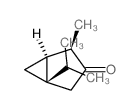Thujone, a component of medicinal herbs, rescues palmitate-induced insulin resistance in skeletal muscle.
Hakam Alkhateeb, Arend Bonen
Index: Am. J. Physiol. Regul. Integr. Comp. Physiol. 299(3) , R804-12, (2010)
Full Text: HTML
Abstract
Thujone is thought to be the main constituent of medicinal herbs that have antidiabetic properties. Therefore, we examined whether thujone ameliorated palmitate-induced insulin resistance in skeletal muscle. Soleus muscles were incubated for < or =12 h without or with palmitate (2 mM). Thujone (0.01 mg/ml), in the presence of palmitate, was provided in the last 6 h of incubation. Palmitate oxidation, AMPK/acetyl-CoA carboxylase (ACC) phosphorylation and insulin-stimulated glucose transport, plasmalemmal GLUT4, and AS160 phosphorylation were examined at 0, 6, and 12 h. Palmitate treatment for 12 h reduced fatty acid oxidation (-47%), and insulin-stimulated glucose transport (-71%), GLUT4 translocation (-40%), and AS160 phosphorylation (-26%), but it increased AMPK (+51%) and ACC phosphorylations (+44%). Thujone (6-12 h) fully rescued palmitate oxidation and insulin-stimulated glucose transport, but only partially restored GLUT4 translocation and AS160 phosphorylation, raising the possibility that an increased GLUT4 intrinsic activity may also have contributed to the restoration of glucose transport. Thujone also further increased AMPK phosphorylation but had no further effect on ACC phosphorylation. Inhibition of AMPK phosphorylation with adenine 9-beta-d-arabinofuranoside (Ara) (2.5 mM) or compound C (50 muM) inhibited the thujone-induced improvement in insulin-stimulated glucose transport, GLUT4 translocation, and AS160 phosphorylation. In contrast, the thujone-induced improvement in palmitate oxidation was only slightly inhibited (< or =20%) by Ara or compound C. Thus, while thujone, a medicinal herb component, rescues palmitate-induced insulin resistance in muscle, the improvement in fatty acid oxidation cannot account for this thujone-mediated effect. Instead, the rescue of palmitate-induced insulin resistance appears to occur via an AMPK-dependent mechanism involving partial restoration of insulin-stimulated GLUT4 translocation.
Related Compounds
| Structure | Name/CAS No. | Molecular Formula | Articles |
|---|---|---|---|
 |
α-Thujone
CAS:546-80-5 |
C10H16O |
|
Attempts to separate (-)-α-thujone, (+)-β-thujone epimers fr...
2013-03-01 [J. Sep. Sci. 36(5) , 832-9, (2013)] |
|
Long-term stability of thujone, fenchone, and pinocamphone i...
2009-04-08 [J. Agric. Food Chem. 57(7) , 2782-5, (2009)] |
|
Toxicokinetics of α-thujone following intravenous and gavage...
2013-09-01 [Toxicol. Appl. Pharmacol. 271(2) , 216-28, (2013)] |
|
Skeletal muscle fatty acid oxidation is not directly associa...
2011-06-01 [Appl. Physiol. Nutr. Metab. 36(3) , 361-7, (2011)] |
|
Metabolism of α-thujone in human hepatic preparations in vit...
2011-02-01 [Xenobiotica 41(2) , 101-11, (2011)] |